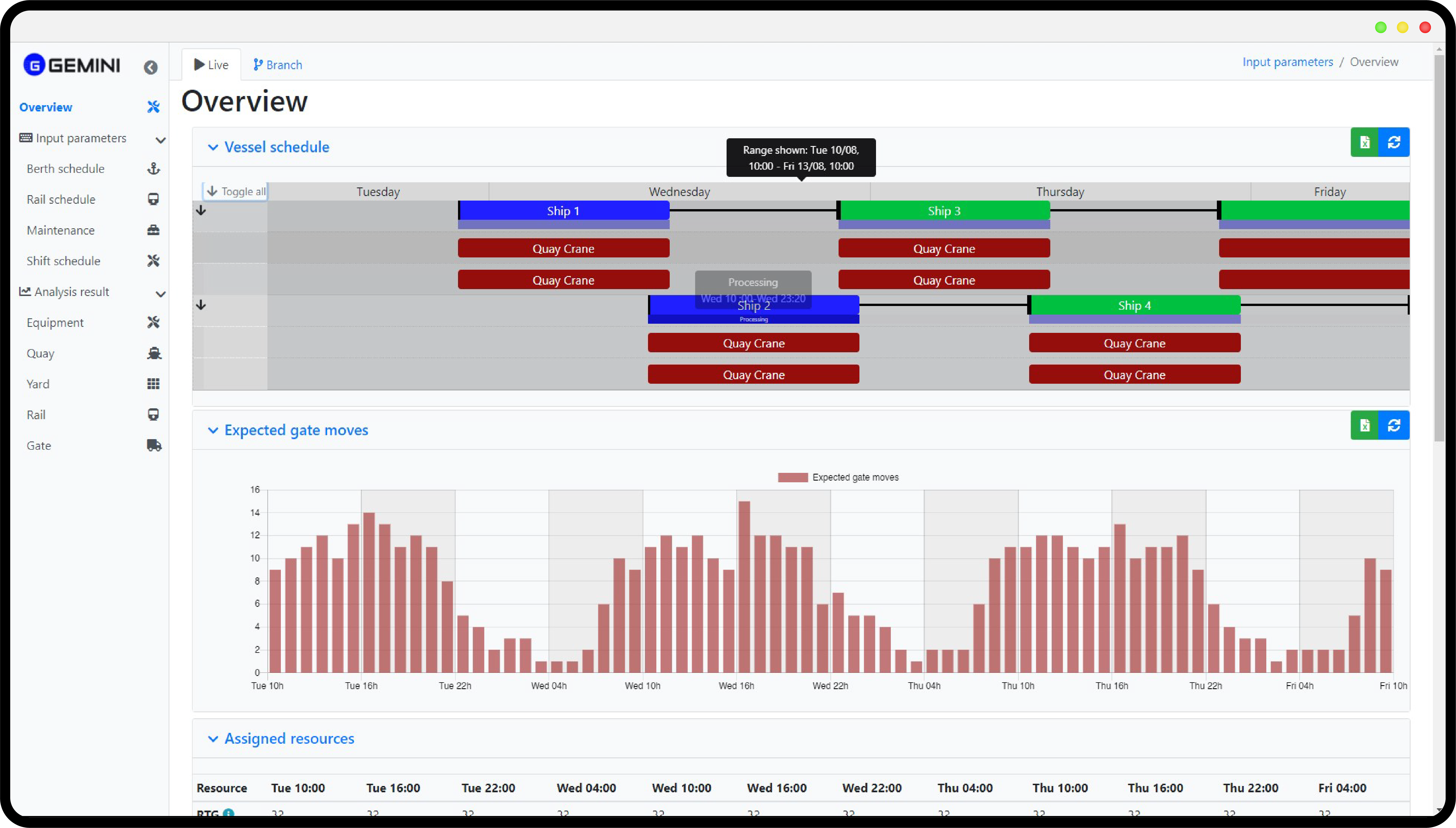Modules & Features
GEMINI product is a feature rich product that will drive you in one of the most challenging effort for container terminals: emulate its current process and create what-if scenario in case of innovative solutions.
A digital twin capable to mirror decisions and strategies of the Terminal Operating System (TOS) algorithms and to model all other sub-systems behavior and workers practice during real operations.
GEMINI is a modular solution that can be built around the terminals needs, providing 5 different modules:

BUSINESS INTELLIGENCE
DSP BI, Dataview, is integrated for analytics and historical reports
A reliable unique source of data and KPI’s within the organisation. A flexible tool able to progress together with your business. Transparent formula of KPI calculations. Easy and secure access from any mobile devices. Dynamic reporting capability in the hands of the end user. Live performance indicators. Operational and financial figures to transform data into decision-making material and support what-if analysis for commercial decisions. Open to self-development and maintenance.

FORECAST
Forecast resource demand and strategies
With the first Module Forecast, GEMINI can be immediately be used by operations supporting their decision process with predictive analysis and monitoring the identified KPIs.
GEMINI utilises 3 different levels of data and merge the output to deliver the results with a short-, mid- and long-term forecast. The accuracy will increase in the shorter time horizons as the data becomes further enriched.
As the assumptions are based on having mixed flows utilising all the yard equipment, the users have the ability to create different scenarios based upon variable equipment resources. This will impact the results for each scenario and give insight into the decision and actions to be taken.
Containers information and forecast will be available in their respective flow views and sections: Quay, Gate, Rail, Yard.
Quay
The quay module displays a view of the berths, vessel operational times, throughput and the quay cranes assigned to each vessel.
Configurable parameters are available to optimize the berth utilisation.
Relative vessel size, berth size/dimensions and quay crane specifications are integrated in to the forecast.
Rail
The Rail module is very close to the Quay module. The rail plan is reasonably fixed therefore the throughput per hour / day is highly predicable. This in turn determines the demand on the yard per hour and how many trucks are required for the horizontal transport for moving containers between the rail terminal and yard.
The value of the Rail module is to identify peaks and troughs in rail throughput over time horizons and ideally smooth the curve of demand to avoid congestion and delays and improve flow. In case the foreseen productivity is low; the rail supervisor can take the right action by planning a housekeeping or adding more equipment.
Gate
With the Gate module tactical business decisions and rules can be applied to smooth out demand which in turn will create a more stable flow on the yard and avoid congestion and exceeding yard handling capacity.
The value of this module positively impacts the Resource manager/Equipment manager/ Gate supervisor – delivering a resource plan based upon historic data and also a forecast based upon live data calculated by moves per in time horizons.
The Gate module is designed to monitor and plan the expected gate throughput. This will provide a detailed insight in to how many trucks and containers are expected to flow in and out of the terminal in varied time horizons. With this information it will provide a template for how many gate lanes in and out are required, gate and tally checker requirements and opening hours.
Yard
The yard module gives deeper insight on the demand for the yard especially over the short-term.
Essentially, how many container moves are expected from the move kind (inbound /outbound in the yard). This is derived from the berthing plan, rail plan and expected gate transactions and calculated in to time horizons. The yard capacity for handling containers is finite and determined by the sum of MPH for combined yard equipment.
This module will assist the yard planners, for example to foresee the yard capacity after a specific vessel ends operations, or may predict a clash between different move types at a specific hour. Therefore, make the right actions to avoid congestion and will help on defining the preferred strategy to manage the different move types in the different yard blocks for a specific shift.
Equipment
The Equipment module allows the user to gain visibility of the equipment requirements. This functionality includes the equipment ratio requirements based on the forecast and throughput split in different time horizons. This data will be updated and synchronized with the integrated TOS.
This module is designed for the optimisation of equipment resource nd labour planning, improving visibility and planning of the equipment resource.

SIMULATION
Run simulations on your digital twin to validate new process and layout design

EMULATION
Terminal Optimization (scheduling and planning)

3D VIEWS
